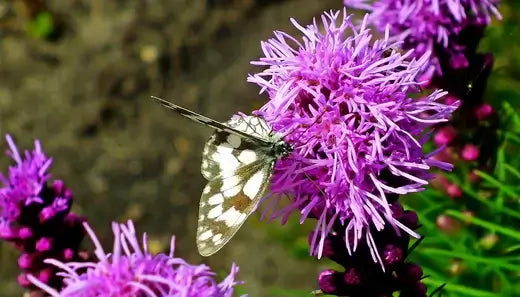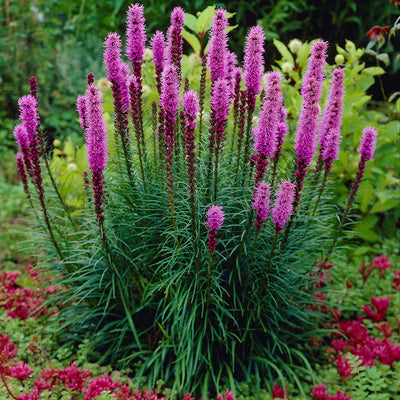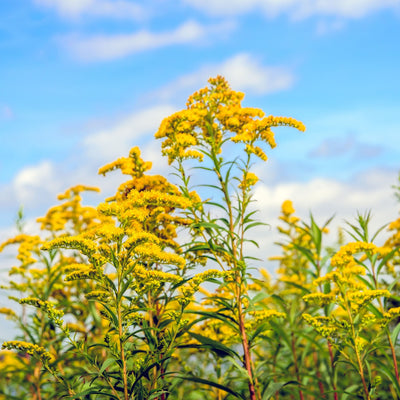Blazing Star
Adding vibrant and eye-catching plants can transform the overall ambiance, whether you have a small garden, a spacious backyard, or a sprawling estate. One such plant that can bring elegance and charm to your landscape is the Blazing Star (Liatris spicata).
Overview of the Blazing Star:
The Blazing Star, also known as Gayfeather or Liatris spicata, is a perennial plant native to America. It belongs to the Asteraceae family and is renowned for its distinctive tall spikes of dense, vibrant flowers. The flowers typically bloom in shades of purple, lavender, pink, and white, creating a striking visual display that attracts butterflies, bees, and other pollinators to your garden.
Cultivation and Care:
Climate and Soil Requirements: Blazing Star thrives in full sun to partial shade conditions, making it a versatile choice for various landscapes. It prefers well-drained soils but can adapt to multiple soil types.
Planting: Blazing stars can be propagated from seeds or established plants. Spring or early fall is the ideal time for planting, allowing the plant to develop its root system before the extreme summer or winter temperatures.
Watering and Maintenance: Once established, Blazing Star is relatively low-maintenance. Regular watering during dry periods and removing spent flower spikes will encourage continuous blooming and maintain a tidy appearance.
Pruning and Division: Blazing Star may benefit from division every few years to maintain vigor and prevent overcrowding. Pruning in early spring can also help control the plant's height and promote bushier growth.
Design Ideas for Blazing Star:
Border Planting: The tall spikes of the Blazing Star make it an excellent choice for creating borders and hedges in your garden. Its vertical growth adds structure and visual interest, while the flowers provide a burst of color throughout the growing season.
Mixed Perennial Beds: Combine Blazing Star with other perennials such as Coneflowers, Black-eyed Susans, and Daylilies to create vibrant and dynamic mixed beds. The varying heights, textures, and colors will add depth and complexity to your landscape.
Cottage Gardens: Blazing Star's elegant and whimsical appearance fits perfectly in cottage garden settings. Combine it with flowering shrubs, ornamental grasses, and climbing roses to create a romantic and enchanting atmosphere.
Naturalized Areas: Blazing Star can also be used in meadow gardens or naturalized areas. Its upright form and colorful blooms provide a vertical element to the landscape while blending harmoniously with native grasses and wildflowers.
Companion Planting:
Attracting Pollinators: Blazing Star's nectar-rich flowers are irresistible for bees, butterflies, and hummingbirds. Plant it alongside other pollinator-friendly flowers like Bee Balm, Salvia, and Butterfly Bush to create a haven for these beneficial creatures.
Contrasting Foliage: Pair Blazing Star with plants with contrasting foliage colors and textures to create a visually appealing combination. For instance, the Blazing Star's feathery foliage complements Hostas's broad leaves or Lamb's Ear's silver foliage.
Historical Significance: The Blazing Star has a deep-rooted history in North America, where it is native. Native American tribes, such as the Cherokee and the Iroquois, revered this plant for its medicinal and spiritual properties. They believed the Blazing Star possessed healing abilities and used them in traditional remedies for ailments such as coughs, fevers, and stomach issues. The plant's tall spikes and vibrant flowers were also incorporated into ceremonial rituals, representing strength and resilience.
Medicinal Uses:
Diuretic and Kidney Support: Blazing Star has diuretic properties, promoting increased urine production. Native Americans used parts of the Blazing Star to support kidney health and aid in the elimination of toxins from the body.
Respiratory Relief: The roots of Blazing Star were used in herbal preparations to relieve respiratory conditions such as coughs, congestion, and bronchitis. It was believed to have expectorant properties that helped clear the airways.
Anti-inflammatory Effects: Blazing Star was utilized topically as a poultice or salve to reduce inflammation and soothe skin irritations, including rashes and bug bites.
Ecological Benefits:
Pollinator Attraction: Blazing Star's vibrant flowers serve as a valuable food source for pollinators like bees, butterflies, and hummingbirds. By planting Blazing Star in your garden, you can support local pollinator populations and contribute to the overall health of your ecosystem.
Wildlife Habitat: The vertical structure of Blazing Star provides shelter and nesting opportunities for small birds and beneficial insects. The plant's seedheads also offer a food source for birds during winter.
Blazing Star Is A Vibrant Perennial
Its vertical growth adds height and structure to the landscape, while the striking blooms create a focal point and attract attention.
Cut Flower Arrangements: Blazing Star's long-lasting flowers, both fresh and dried, are favored by florists for their unique appearance and architectural beauty. The vibrant spikes add an element of drama to floral arrangements and bouquets.
Butterfly and Pollinator Gardens:
Due to its nectar-rich flowers, Blazing Star is highly sought after for butterfly gardens and pollinator-friendly landscapes. Its blooms act as a beacon, attracting a diverse range of pollinators and providing them with a vital source of sustenance.
Cultural Significance: Blazing Star has also gained popularity beyond its practical uses and ecological benefits. Its striking appearance and historical significance have symbolized strength, resilience, and natural beauty. It is often featured in floral arrangements for special events, weddings, and celebratory occasions.
In conclusion, the Blazing Star holds a captivating history and a range of practical uses. From its ancient medicinal applications to its ecological benefits and ornamental appeal, this remarkable plant continues to be cherished and valued in various aspects of our lives. Whether incorporating it into your garden or appreciating its symbolic significance, the Blazing Star remains a beloved and cherished addition to landscapes worldwide.
Companion Plants For Blazing Star



